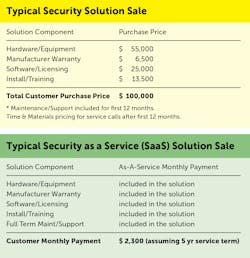This article originally appeared in the July 2020 issue of Security Business magazine. When sharing, don’t forget to mention @SecBusinessMag on Twitter and Security Business magazine on LinkedIn.
The concept of security as a service (SaaS) continues to evolve as the integrator, the security end-user and the marketplace looks at the process in ways that can better benefit all parties.
Historically, the transaction between integrator and customer has been – putting it in the simplest of terms – to spec and install a system, exchange a check and call it good, as illustrated in the nearby example of a solution sale. This is a commodity-based transaction that may have some service and support built in for a limited period; however, the ownership and responsibility of the equipment ultimately lies with the end-user, and the integrator’s team is then charged with looking for new customers and making the next sale.
Unfortunately, this type of transaction cannot accommodate key changes occurring in the marketplace. Among those changes, integrators are on a quest to build recurring revenue, and customers no longer favor ownership. As witnessed in our everyday lives, more people want the ability to access technology – whether it is smartphones or streaming services – but without the burden of ownership. That is especially key in an area such as security, where technology changes rapidly and maintenance within an end-user’s organization can require skilled in-house staff and unexpected costs.In contrast to the cash sale transaction in the graphic, a security as-a-service solution can be a great alternative that addresses the new objectives of both the customer and the integrator. As-a-service is just another way of saying subscription service – and like any subscription service, the expectation is that an entire solution is provided for a defined monthly payment that does not result in ownership.
The Financing Aspect of the Equation
The obvious realization by integrators is that they need to find a way to convert that $100,000 cash price ask into the $2,300 monthly payment. Logically, that means financing of some sort must play a role in the integrator’s ability to offer customers as-a-service solutions. With the right financing partner, as-a-service options can be structured so that the integrator can still generate immediate revenue equivalent to an upfront cash sale as well as realize recurring revenue from multi-year service and support commitments.
Continuing with our transaction example, the integrator should look for a finance partner who can fund the integrator $100,000 up front; fund the integrator $300-400/month for maintenance and support (amount will vary depending on integrator service contract, but will be paid for an assumed five-year service term); and allow the customer to simply pay $2,300/month for the as-a-service solution (for assumed five-year service term).
As integrators search for a finance partner who can help create such an as-a-service offering, they will need to be selective. The overwhelming majority of traditional financing programs will not completely match the expected attributes of as-a-service solutions; thus, integrators should ask many questions and ensure they understand the nature of the payment programs available with any potential finance partner.
Shifting Your Business Model
At the transaction level, the ability to offer customers a predictable monthly payment is fundamental to as-a-service solutions; however, an integrator having the ability to provide an as-a-service solution option is very different than an integrator adopting an as-a-service model as their go-to-market sales strategy. This concept is critical because financing and the right type of monthly payment is only one step on the path to being successful selling as-a-service solutions.
There are four steps that are vitally important for a systems integrator to successfully adopt this type of sales model shift:
1. Get full management buy-in. Some executives may look at an RMR plan as a sales-only issue; however, making this a focus for a company means having people at all levels – starting with those at the top – see the benefits of the pivot. The leadership commitment has to continue beyond the initial “go for it” stage through inspection and enforcement of all the key steps.
The integrator’s top management personnel should hold people accountable for their specific roles to garner success with the SaaS model.
2. The ability to carry out the service piece. If an integrator is selling multi-year maintenance services, they obviously need the people and the expertise to support it. This means knowing the ins and outs of the technology, having staff who are focused on service rather than just sales, and being able and available to respond when needed.
Customers who rely on an integrator for support through their SaaS model will have a higher expectation for service than if the company had just sold them a system and walked away.
3. Make it clear to the customer what is being offered. What are the different levels of service they can purchase? What do these levels provide? It can be helpful to present at least two service levels: One is a high-end 24/7, seven-days-a-week program; while the other more modest for those who can get by with a 9-to-5, weekday option.
Whatever models are created, they should be clearly articulated and branded so customers and internal sales and service people know the particular components in the Gold vs. Silver or A vs. B plans.
As an extension of service and support, what if the customer wants to upgrade or replace the security system before the end of a service term? While a few solutions are sold with supposed tech refresh capabilities, integrators need to determine whether they are able to provide such a feature, how it would function and whether it is truly beneficial to their customers – particularly if traditional financing is the mechanism to create it.
Although customers may be able to upgrade, they remain responsible for any remaining payments left on their original term, and they also may incur penalty or change fees. All of these amounts are in addition to the new solution payment requirement. If integrators are going to promote and support some type of protection against technology change, they need to find a way to make it fit in the as-a-service mold without creating painful financial consequences for their customers.
4. Messaging and Sales. One of the best ways to ensure customers are clear on what an integrator is doing is to make the SaaS plan more than a sales pitch; in fact, it should be an integral part of a company’s overall messaging. Whether through blogs on the website, social media, videos, trade advertising or other presentations, explaining why an integrator is taking this new approach, what is being offered, how it is different and the benefits it provides shows that the integrator has embraced this concept as a key part of their business.
Once you have buy-in from leadership, the proper support services and messaging, a honed sales training program that moves your team away from a cash sales model and to a non-ownership, monthly payment one is essential.
This can be the toughest part, since integrators have been selling systems – not services – for a long time. The conversion to a new selling style may require bringing in a third-party training firm to help salespeople pivot to this new way of thinking.
Another consideration on the sales side is how will salespeople be compensated as they make this switch. As the SaaS RMR model improves the bottom line for the business, it should benefit those putting it in place as well.
Paul Metzheiser is a managing partner for TAMCO (www.tamcocorp.com), a telecommunications and technology leasing company offering OPEX and traditional financing options that empower integrators to present a comprehensive solution to clients.




